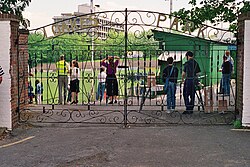
Molineux Stadium is a football stadium situated in Wolverhampton, West Midlands, England. It has been the home ground of Premier League club Wolverhampton Wanderers since 1889. The first stadium built for use by a Football League club, it was one of the first British grounds to have floodlights installed and hosted some of the earliest European club games in the 1950s.
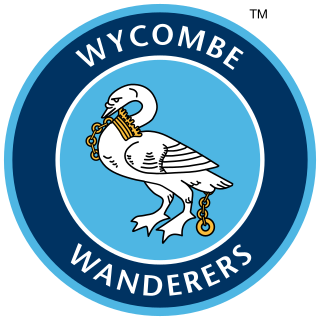
Wycombe Wanderers Football Club is a professional association football club based in the town of High Wycombe, Buckinghamshire, England. The team competes in League One, the third level of the English football league system.

Villa Park is a football stadium in Aston, Birmingham, with a seating capacity of c.42,900. It has been the home of Premier League club Aston Villa since 1897. The ground is less than a mile from both Witton and Aston railway stations and has hosted sixteen England internationals at senior level, the first in 1899 and the most recent in 2005. Villa Park has hosted 55 FA Cup semi-finals, more than any other stadium, and it is the 10th largest in England.
The Hawthorns is an all-seater football stadium in West Bromwich, West Midlands, England, with a capacity of 26,688. It has been the home of Championship club West Bromwich Albion since 1900, when it became the sixth ground to be used by the club. The Hawthorns was the first Football League ground to be built in the 20th century, opening in September 1900 after construction work took only 4 months. The official record attendance at The Hawthorns stands at 64,815, set in 1937.
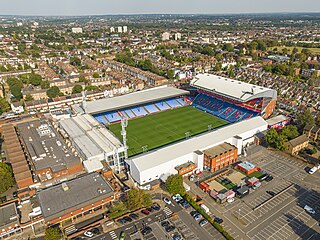
Selhurst Park is a football stadium in Selhurst, in the London Borough of Croydon, England, which is the home ground of Premier League club Crystal Palace. The stadium was designed by Archibald Leitch and opened in 1924. It has hosted international football, as well as games for the 1948 Summer Olympics. It was shared by Charlton Athletic from 1985 to 1991 and Wimbledon from 1991 to 2003.

Kenilworth Road, known affectionately as The Kenny, is an association football stadium in Bury Park, Luton, Bedfordshire, England. It has been the home ground of Luton Town since 1905. The stadium has also hosted women's and youth international matches, including the second leg of the 1984 European Competition for Women's Football final.

Adams Park is a football stadium in High Wycombe, Buckinghamshire, England. Built in 1990, it is the home ground of the local Wycombe Wanderers Football Club in League One. It was also leased from 2002 to 2014 to the rugby union club London Wasps from Aviva Premiership, and from 2016 to 2020 to the Reading F.C. Women football club. From the 2003–04 season to the 2005–06 season, the stadium was officially called Causeway Stadium, named after its sponsor Causeway Technologies.

Home Park is a football stadium in Plymouth, England. The ground has been the home of EFL Championship club Plymouth Argyle since 1901.

Ewood Park is a football stadium in Blackburn, Lancashire, England, and the home of Blackburn Rovers F.C., founding members of the Football League and Premier League, who have played there since 1890. It is an all seater multi-sports facility with a capacity of 31,367, and four sections: the Bryan Douglas Darwen End, The Ronnie Clayton Blackburn End, the Riverside Stand, and Jack Walker Stand, named after Blackburn industrialist and club supporter, Jack Walker. The football pitch within the stadium measures 115 by 76 yards
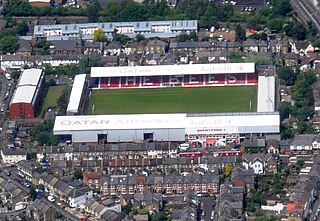
Griffin Park was a football ground in Brentford in the London Borough of Hounslow, England. It was the home ground of Brentford F.C. from its opening in September 1904 to August 2020. The ground was in a predominantly residential area and was known for being the only English league football ground to have a pub on each corner. The ground's name referred to the griffin featured in the logo of Fuller's Brewery, which at one point owned the orchard on which the stadium was built.
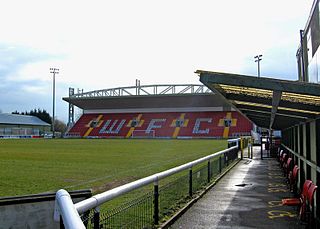
Kingfield Stadium, currently known as The Laithwaite Community Stadium for sponsorship reasons, is a football stadium in the Kingfield area of Woking, Surrey, and is the home of Woking Football Club which has a capacity of approximately 6,000, of which 2,500 are seated on grandstands.

Bootham Crescent in York, England, was the home of York City Football Club and York City Knights rugby league club. With a capacity of 8,256, it was near the city centre, just over a mile from York railway station. As of February 2023 the ground has been fully demolished to make way for the building of new houses.

Underhill Stadium was a stadium in Chipping Barnet, London, that was the home of Barnet Football Club between 1907 and 2013. The club's under-19 team played fixtures there; it was also the training ground of the London Broncos rugby league club, and hosted Arsenal reserve games until 2012. At the time of its closure, the stadium had a capacity of 6,023; it was demolished in 2018, and is now the site of the Ark Pioneer Academy, which opened in 2019. The stadium was famous for its slope from the North to South end.
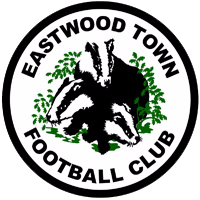
Eastwood Town Football Club was an English football club based in Eastwood, Nottinghamshire. The club last participated in the Northern Premier League Division One South, the eighth tier of English football.
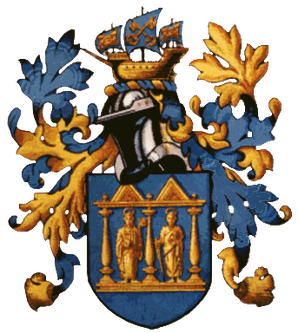
Wisbech Town Football Club is a football club based near Wisbech, Cambridgeshire, England. The club are currently members of the United Counties League Premier Division North and play at the Fenland Stadium.

Prenton Park is a large outdoor seated association football stadium in Birkenhead, England. It is the home ground of Tranmere Rovers. The ground has had several rebuilds, with the most recent occurring in 1995 in response to the requirement of the Taylor Report to become all-seater. Today's stadium holds 16,587 in four stands: the Kop, the Johnny King Stand, the Main Stand and the Cowshed.

York Road is a football stadium in Maidenhead, Berkshire, England. The home ground of Maidenhead United, it is acknowledged by The Football Association and FIFA to be the oldest continuously-used senior association football ground in the world by the same club, having been home to the club since 1871. A blue plaque commemorating this is placed just inside the home turnstiles on the York Road side of the ground.
The history of Wycombe Wanderers F.C. covers the full history of the club from its formation to the last completed season and even its recent years.
Brian Russell Lee MBE was a British football manager, coach, and administrator, most notable for his associations with Wycombe Wanderers and Bisham Abbey. He was appointed a Member of the Order of the British Empire (MBE) in the 2016 New Year Honours for services to football, and a Services to Football Award by the League Managers Association (LMA) in 2016.
